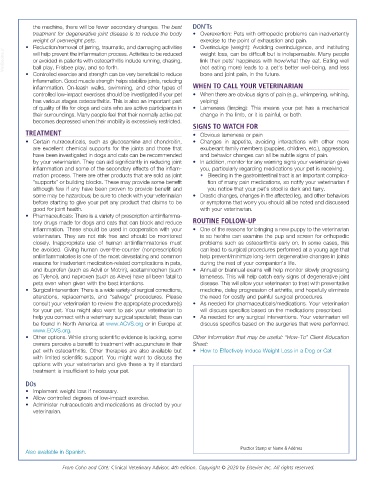Page 3090 - Cote clinical veterinary advisor dogs and cats 4th
P. 3090
the machine, there will be fewer secondary changes. The best DON’Ts
treatment for degenerative joint disease is to reduce the body • Overexertion: Pets with orthopedic problems can inadvertently
weight of overweight pets. exercise to the point of exhaustion and pain.
• Reduction/removal of jarring, traumatic, and damaging activities • Overindulge (weight): Avoiding overindulgence, and instituting
VetBooks.ir or avoided in patients with osteoarthritis include running, chasing, link their pets’ happiness with how/what they eat. Eating well
will help prevent the inflammation process. Activities to be reduced
weight loss, can be difficult but is indispensable. Many people
ball play, Frisbee play, and so forth.
(not eating more) leads to a pet’s better well-being, and less
• Controlled exercise and strength can be very beneficial to reduce bone and joint pain, in the future.
inflammation. Good muscle strength helps stabilize joints, reducing
inflammation. On-leash walks, swimming, and other types of WHEN TO CALL YOUR VETERINARIAN
controlled low-impact exercises should be investigated if your pet • When there are obvious signs of pain (e.g., whimpering, whining,
has various stages osteoarthritis. This is also an important part yelping)
of quality of life for dogs and cats who are active participants in • Lameness (limping): This means your pet has a mechanical
their surroundings. Many people feel that their normally active pet change in the limb, or it is painful, or both.
becomes depressed when their mobility is excessively restricted.
SIGNS TO WATCH FOR
TREATMENT • Obvious lameness or pain
• Certain nutraceuticals, such as glucosamine and chondroitin, • Changes in appetite, avoiding interactions with other more
are excellent chemical supports for the joints and those that exuberant family members (puppies, children, etc.), aggression,
have been investigated in dogs and cats can be recommended and behavior changes can all be subtle signs of pain.
by your veterinarian. They can aid significantly in reducing joint • In addition, monitor for any warning signs your veterinarian gives
inflammation and some of the secondary effects of the inflam- you, particularly regarding medications your pet is receiving.
mation process. There are other products that are sold as joint • Bleeding in the gastrointestinal tract is an important complica-
“supports” or building blocks. These may provide some benefit tion of many pain medications, so notify your veterinarian if
although few if any have been proven to provide benefit and you notice that your pet’s stool is dark and tarry.
some may be hazardous; be sure to check with your veterinarian • Drastic changes, changes in the affected leg, and other behaviors
before starting to give your pet any product that claims to be or symptoms that worry you should all be noted and discussed
good for joint health. with your veterinarian.
• Pharmaceuticals: There is a variety of prescription antiinflamma-
tory drugs made for dogs and cats that can block and reduce ROUTINE FOLLOW-UP
inflammation. These should be used in cooperation with your • One of the reasons for bringing a new puppy to the veterinarian
veterinarian. They are not risk free and should be monitored is so he/she can examine the pup and screen for orthopedic
closely. Inappropriate use of human antiinflammatories must problems such as osteoarthritis early on. In some cases, this
be avoided. Giving human over-the-counter (nonprescription) can lead to surgical procedures performed at a young age that
antiinflammatories is one of the most devastating and common help prevent/minimize long-term degenerative changes in joints
reasons for inadvertent medication-related complications in pets, during the rest of your companion’s life.
and ibuprofen (such as Advil or Motrin), acetaminophen (such • Annual or biannual exams will help monitor slowly progressing
as Tylenol), and naproxen (such as Aleve) have all been fatal to lameness. This will help catch early signs of degenerative joint
pets even when given with the best intentions. disease. This will allow your veterinarian to treat with preventative
• Surgical intervention: There is a wide variety of surgical corrections, medicine, delay progression of arthritis, and hopefully eliminate
alterations, replacements, and “salvage” procedures. Please the need for costly and painful surgical procedures.
consult your veterinarian to review the appropriate procedure(s) • As needed for pharmaceuticals/medications. Your veterinarian
for your pet. You might also want to ask your veterinarian to will discuss specifics based on the medications prescribed.
help you connect with a veterinary surgical specialist; these can • As needed for any surgical interventions. Your veterinarian will
be found in North America at www.ACVS.org or in Europe at discuss specifics based on the surgeries that were performed.
www.ECVS.org.
• Other options. While strong scientific evidence is lacking, some Other information that may be useful: “How-To” Client Education
owners perceive a benefit to treatment with acupuncture in their Sheet:
pet with osteoarthritis. Other therapies are also available but • How to Effectively Induce Weight Loss in a Dog or Cat
with limited scientific support. You might want to discuss the
options with your veterinarian and give these a try if standard
treatment is insufficient to help your pet.
DOs
• Implement weight loss if necessary.
• Allow controlled degrees of low-impact exercise.
• Administer nutraceuticals and medications as directed by your
veterinarian.
Practice Stamp or Name & Address
Also available in Spanish.
From Cohn and Côté: Clinical Veterinary Advisor, 4th edition. Copyright © 2020 by Elsevier Inc. All rights reserved.

